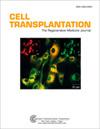用于脊髓修复的细胞移植以及产生区域特异性外源性神经元细胞的前景
IF 3.2
4区 医学
Q3 CELL & TISSUE ENGINEERING
引用次数: 0
摘要
脊髓损伤(SCI)会对中枢神经系统的多个功能部分造成目前不可逆转的后果。尽管脊髓损伤十分严重,但目前仍没有获准用于恢复功能的治疗方法。不过,随着临床前研究和临床试验的不断增加,细胞移植作为脊髓损伤的一种治疗方法已经获得了巨大的潜力。研究人员已经确定了几种细胞类型作为潜在的移植候选者。为了优化移植后的成功功能结果,一个关键因素是生成具有区域和亚型特异性的神经元细胞,从而利用脊髓细胞的发育转录组模式。脊髓细胞移植的一个潜在来源是通过基因编辑和囊胚补体等新兴技术产生外源性神经元祖细胞。本综述强调了在相关发育基因表达模式的背景下利用细胞移植治疗 SCI 的方法,这些基因表达模式有助于通过体外分化和囊胚补体产生区域特异性外源性脊髓细胞。本文章由计算机程序翻译,如有差异,请以英文原文为准。
Cell Transplantation for Repair of the Spinal Cord and Prospects for Generating Region-Specific Exogenic Neuronal Cells
Spinal cord injury (SCI) is associated with currently irreversible consequences in several functional components of the central nervous system. Despite the severity of injury, there remains no approved treatment to restore function. However, with a growing number of preclinical studies and clinical trials, cell transplantation has gained significant potential as a treatment for SCI. Researchers have identified several cell types as potential candidates for transplantation. To optimize successful functional outcomes after transplantation, one key factor concerns generating neuronal cells with regional and subtype specificity, thus calling on the developmental transcriptome patterning of spinal cord cells. A potential source of spinal cord cells for transplantation is the generation of exogenic neuronal progenitor cells via the emerging technologies of gene editing and blastocyst complementation. This review highlights the use of cell transplantation to treat SCI in the context of relevant developmental gene expression patterns useful for producing regionally specific exogenic spinal cells via in vitro differentiation and blastocyst complementation.
求助全文
通过发布文献求助,成功后即可免费获取论文全文。
去求助
来源期刊

Cell Transplantation
生物-细胞与组织工程
CiteScore
6.00
自引率
3.00%
发文量
97
审稿时长
6 months
期刊介绍:
Cell Transplantation, The Regenerative Medicine Journal is an open access, peer reviewed journal that is published 12 times annually. Cell Transplantation is a multi-disciplinary forum for publication of articles on cell transplantation and its applications to human diseases. Articles focus on a myriad of topics including the physiological, medical, pre-clinical, tissue engineering, stem cell, and device-oriented aspects of the nervous, endocrine, cardiovascular, and endothelial systems, as well as genetically engineered cells. Cell Transplantation also reports on relevant technological advances, clinical studies, and regulatory considerations related to the implantation of cells into the body in order to provide complete coverage of the field.
 求助内容:
求助内容: 应助结果提醒方式:
应助结果提醒方式:


